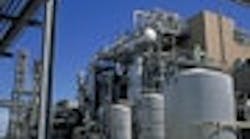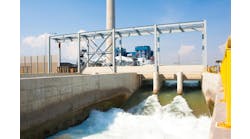According to the American Chemistry Council (ACC), Arlington, Va., the U.S. chemical industry has halved energy consumed per unit of output since 1974. However, companies see substantial further opportunities for savings.
For instance, Air Products & Chemicals, Allentown, Pa., aims to cut both energy consumption at its large air separation units (ASUs) and fuel and feedstock consumption at its hydrogen, carbon monoxide and synthesis gas (HyCO) facilities by 7% by 2015 compared to a 2007 baseline. The company is focusing particularly on ASUs and HyCO facilities because together they account for 80% of its global energy requirements.
"For some chemical plant operators, electricity and gas are still thought of as utilities. In these two major lines, however, they are treated as raw materials. For example, air is free for an ASU, so most of our variable costs involved are for electricity, which we regard as a raw material in the separation process. So essentially we have been focused on energy efficiency for our whole history. Seven percent might not sound like a lot, but it is higher than historical improvements," says Steve Pastore, director for global energy supply.
The company now is taking a four-pronged approach to enhancing energy efficiency:
- The R&D and Technology Group is focusing on long-term process design and cycle improvements as well as short-term measures to boost ASU and HyCo performance. The group has yearly dollar improvement targets.
- Air Products' whole worldwide portfolio of plants is being assessed; several older ones currently are being replaced.
- The about-100 people globally in its process plant efficiency group are exclusively concentrating on plant efficiency using, for example, lean and six sigma approaches. Best practices -- e.g., more efficient operation of a cooling tower or an on-the-fly process control alteration -- are shared.
- The company has implemented new operation service centers (OSCs) globally that bring together a lot more plants: the company has over 100 in North America alone. The OSCs are staffed with operators and plant efficiency engineers. They use state-of-the-art data tools and process metrics. The efficiency engineers look at all the data, the differences in efficiencies in similar plants, even ones geographically far apart, and ask, "Why?" Previously, notes Pastore, operators were very much consumed with what was happening at their own plants and didn't have the opportunity to see this broader picture.
"A good example of implementing a new process cycle improvement is the ASU being built for PetroChina," he says. It marks the first time that a state-owned refinery in China has outsourced its hydrogen requirements. The facility will produce over 90 million standard cubic feet per day of hydrogen and is targeted to be on stream in early 2012.
The hydrogen production plant will feature technology advancements to maximize facility energy efficiency and emission reductions. The enhanced steam methane reforming design, by partner Technip, targets minimal heat loss to the environment, which in turn decreases the quantity of natural gas required to make hydrogen.
Air Products also offers its Oxyfuel technology to help customers improve the energy efficiency of combustion processes. This saves fuel and cuts carbon dioxide emissions. Its latest use is on a CO2-capture pilot plant being commissioned at Vattenfall's site in Schwarze Pumpe, Germany (Figure 1).
And what happens beyond 2015? Pastore says more aggressive targets currently are being assessed -- and they will require taking new approaches. "For example, ion transport membrane (ITM) technology for air separation. This is especially useful for large IGCC [integrated gasification combined cycle] plants -- and large oxygen plants generally -- and a lot of these will be built in the future. We are also looking for the same step change technology on the HyCO side."
THE RIGHT MINDSET
Addressing energy challenges will require smarter, more efficient and sustainable solutions, believes Ellen Kullman, CEO of DuPont, Wilmington, Del. Speaking at the Detroit Economic Club, she added that conservation and more efficient use of existing fossil fuels are critical: "Success will involve multiple technologies, coupled with innovation and collaboration across companies, borders and sectors."
Just such conservation and efficiency measures led the ACC to bestow two 2010 Energy Efficiency Awards on the company's Chambers Works, Deepwater, N.J., for its efforts to reduce plant energy consumption and minimize energy-related environmental impacts. The over-90-year-old complex, which makes more than 500 products, won in the category of "significant improvement in manufacturing plant site." The awards are given annually to honor chemical manufacturing facilities across the country that demonstrate outstanding results in saving energy and reducing related greenhouse gas (GHG) emissions.
The Chambers Works awards recognized efforts that contributed to an elimination of 2,540 metric tons of CO2 emissions.
The first winning project -- "reduce steam trap failures" -- was based on a six sigma blackbelt project. A team of five mechanics and a steam trap surveyor surveyed and repaired the site's steam distribution system. This enabled the site to reduce variable steam usage, decrease emissions and increase process uptime.
The second project -- "thermal insulation evaluation and upgrade" -- involved setting up a team to check zones of high energy loss to identify piping and equipment needing insulation repair.
For the last four years, Owens Corning, Toledo, Ohio, has worked closely with the U.S. Department of Energy (DOE) to improve energy efficiency in its operations. This has involved a combination of technical assistance, tools and training provided by the DOE's Industrial Technologies Program.
One of the key projects is taking place at the company's Santa Clara, Calif., plant that produces 250 million pounds/year of insulation materials. Initially a DOE expert performed an energy assessment on the plant's pumping systems. This identified a number of opportunities, such as consistent operation of the most efficient pumps, retrofitting inefficient pumps, replacing valves and installing variable speed drives -- and generated annual savings of more than $100,000. A subsequent assessment led to putting variable frequency drives on fans and upgrading to a larger compressor.
The company then was able to claim $250,000 in rebates from the local utility, Silicon Valley Power (SVP), which provides financial incentives for energy saving measures. This helped Owens Corning achieve a 1.3-year payback on its efficiency investments.
The latest project involves a site-wide energy assessment of one of the company's fiberglass-insulation plants. Using DOE tools to evaluate fan, pumping, compressed air and process heating systems, improvements have been identified that will result in a 12% reduction in overall plant energy use. (More on this project can be found in the fall 2010 issue of DOE's Energy Matters, http://www1.eere.energy.gov/industry/bestpractices/energymatters/).
MOVING TARGETS
For its part, Celanese, Dallas, Texas, says it met its 2010 targets for energy intensity, safety, GHGs and waste. So, the company has set new targets for 2015.
"We are expanding our strategic internal programs to reduce energy, GHGs and waste intensity while maintaining our strong economic position. We believe this demonstrates that significant environmental improvements are both achievable and compatible with the corporation's growth and financial performance," says CEO Dave Weidman.
The company's new goals include a 20% decrease in energy intensity, a 25% reduction in waste, and a 25% cut in air emissions from 2010 levels.
In November the company announced its intention to construct manufacturing facilities in China and the U.S. to utilize recently developed advanced technology for the production of ethanol. Celanese's route builds on the company's acetyl platform and integrates new technologies to produce ethanol using basic hydrocarbon feedstocks. A planned plant at Clear Lake, Texas, also will support continuing technology development efforts aimed at improving energy efficiency over the next several years (Figure 2).
Meanwhile W. R. Grace, Columbia, Md., ended 2010 with two awards for its energy efficiency efforts.
The company won an Energy Saver Award from the DOE for a 9% cut in total energy usage at its operations in Irondale, Ala., that make fireproofing materials. Employees improved overall pressure in the site's compressed air system, shut off pilot lights, and installed programmable thermostats on plant heaters and HVAC in the office areas and break rooms. The company expects to realize energy savings of 1,091 million BTU annually from these actions and related activities, primarily in electricity and gas usage. Grace already has recouped its investment in the energy savings equipment.
The ACC also recognized Grace with a Responsible Care Energy Efficiency Award for efforts at manufacturing operations in Lake Charles, La., and Baltimore, Md. Collectively, these two sites reduced natural gas and electricity usage by 122 billion BTUs — largely due to the optimization of equipment such as vacuum pumps and spray dryers.
"These actions will assist us in meeting our sustainability goal of reducing the energy intensity of our global operations by 20% per pound of production by 2017," comments William Corcoran, vice president, public and regulatory affairs.
As part of its energy and climate protection goals, BASF, Ludwigshafen, Germany, intends to cut its specific GHG emissions per metric ton of sales by 25%, and the energy efficiency of its production processes by 25% by 2020 compared to 2002.
"This is a very ambitious goal, but also a very important one. We see energy efficiency as the key to combining climate protection, conserving resources and achieving a competitive advantage," notes Ludwigshafen site director Dr. Harald Schwager.
One of the ways the firm is achieving these goals is through developing new technologies jointly with other companies. For example, a project with
Dow Chemical, Midland, Mich., has led to a technology that is said to vastly improve the production process of a key chemical intermediate, propylene oxide (PO). The hydrogen-peroxide-to-propylene-oxide (HPPO) route reportedly offers distinct economic and environmental benefits compared to conventional technologies (Figure 3). A joint study using BASF's Eco-Efficiency Analysis tool revealed the new HPPO process reduces wastewater by 70–80% and energy use by approximately 35% compared to existing PO technology.
FOCUS ON BASICS
Dramatic changes in technology aren't always the answer, though. For instance, ExxonMobil Chemical, Houston, relied on a "back to basics" energy strategy at its Baytown olefins plant to achieve impressive improvements that have been replicated throughout the company. The four-point strategy focused on: optimizing refrigeration; minimizing steam letdown and venting; reducing energy consumption by better matching the number of pumps online to the number actually required; and decreasing steam loss by improving deaerator vents. Costing just $80,000, the project has produced energy savings of 1.153 trillion BTU/year, a reduction in CO2 emissions of 66,650 ton/year and total energy savings of $6.5 million/year. Overall energy savings per unit of production were 4%. "Low/no cost opportunities for improvements in energy efficiency always exist," concludes the company's report on the project.
Seán Ottewell is Chemical Processing's Editor at Large. You can e-mail him at [email protected].

